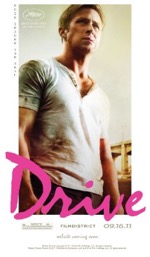Drive (R)
26/01/14 22:02 Filed in: 2011

Starring: Ryan Gosling
September 2011
When I saw the trailer for Drive, I thought it was going to be another of those high-octane, lowbrow car race/chase movies in the mold of the Fast and Furious franchise. How wrong I was. Although centered on cars, specifically a silver Chevy Impala, Drive is more Shakespearian than Vin Dieselian (that didn’t quite roll like I wanted it to). There are plenty of scenes or elements in the movie that hearken back to earlier cinema staples involving a solitary man driving a car at night, the most obvious antecedent being Martin Scorsese’s Taxi Driver. Drive also borrows from a variety of styles/genres, including: films noir (Double Indemnity) and thrillers (Vertigo) in the way it anthropomorphizes the city as an ancillary character in the film with streets and highways representing veins and arteries.
As it turns out, the story more closely resembles a Shakespearian tragedy, particularly Macbeth, than any other car-centric film. Though not quite approaching the bloodletting witnessed in an R-rated splatter fest like Scarface (1983), the film is exceedingly bloody and sees nearly every main character stabbed or shot by movie’s end. However, the movie never crosses the line of becoming gruesome or gratuitous, and, if anything, is artful in how its characters are dispatched. Again, car movies aren’t usually mentioned in the same breath as art films, but Drive comes close to straddling both sides of the street—it’s the perfect balance between a well made mainstream movie and a stylish indie.
And speaking of art, there are some beautiful shots/sequences in the film—and many of them have absolutely nothing to do with cars. There’s an understated scene, with minimal dialogue, where Ryan Gosling and Carey Mulligan converse inside their apartment complex and we see the orange-red glow of a sunset bathing the distant skyscrapers seen through the window the couple is standing in front of…the same hue highlights Mulligan’s hair and back in an ethereal outline. As far as production is concerned, the scene is fairly unremarkable, save for the narrow window of opportunity the crew had to work in before the rapidly setting sun disappeared beyond the horizon and the lighting effect was lost. Besides the execution of the shots, what’s being conveyed between the characters—the subtext—is what’s most fascinating about the scene. Indeed, it could be argued that the lovelorn characters realize, on some innate level, that the kind of relationship they yearn for with each other can never be realized and the setting sun signifies the impending cessation of their friendship.
Even though the themes and mode of storytelling are completely different, there’s something about Drive’s characterizations, pacing and narrative structure that feels similar to a Coen Brothers film, especially Blood Simple (1984). I have no reason to make such a comparison other than my own interpretation of Drive. Although the trappings are divergent in nearly every way, Drive and Blood Simple are examples of thrillers or postmodern films noir. Both movies boast complex characters/relationships, a botched heist and excessive bloodletting.
Another genre quoted from here, although certainly not directly, is the Western. I will stop well short of classifying Drive as a modern Western, but in addition to bounty hunters and shootouts, Gosling’s character is a laconic, rugged individual who is competent not as a gunslinger but as an expert driver. Additionally, Drive turns Western conventions on their ear when Gosling’s character leaves behind a fortune and the woman that he could’ve settled down with, and drives off not into the proverbial sunset but into a pitch black night. The movie also leaves us with a lingering question: Will Gosling’s character even survive since he was wounded in the final confrontation?
The performances here are, fittingly, just as stellar as the performers. Gosling and Mulligan mesmerize as misfortunate lovers, whose ill-timed and ill-fated romance never has the chance to blossom into the kind of lasting relationship they both need and desire. Just as serendipity brings the couple together, tragedy splits them apart. Oh how fickle fate can be. In addition to the dazzling leads, the movie’s supporting players are equally impressive: Albert Brooks, Bryan Cranston and Ron Perlman were all perfectly cast and deliver rich and authentic performances.
Drive is a subtle and engrossing character study and a thinking person’s action film. Some will criticize Drive for not having enough, well…driving in its story or that it needed more action sequences. For me, I just wanted the story to keep going—to learn what would happen next with these characters. Regardless, the movie successfully upholds the old show biz maxim that instructs writers to “always leave them wanting more.” There’s definitely part of me that wants to follow Gosling into that good, dark night to learn the fate of this fascinating lone wolf. Drive on, young Gosling, drive on.
Rating: 3